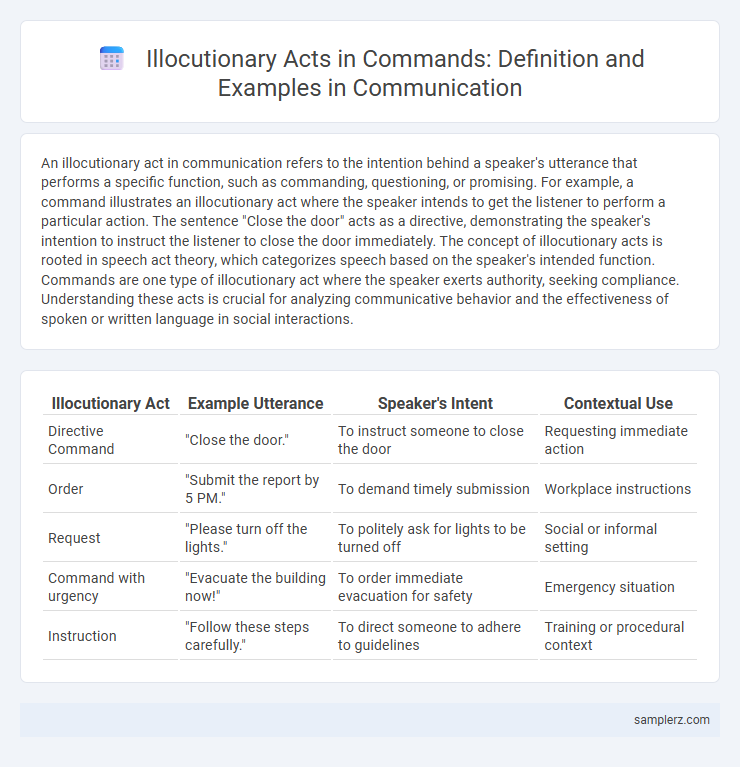An illocutionary act in communication refers to the intention behind a speaker's utterance that performs a specific function, such as commanding, questioning, or promising. For example, a command illustrates an illocutionary act where the speaker intends to get the listener to perform a particular action. The sentence "Close the door" acts as a directive, demonstrating the speaker's intention to instruct the listener to close the door immediately. The concept of illocutionary acts is rooted in speech act theory, which categorizes speech based on the speaker's intended function. Commands are one type of illocutionary act where the speaker exerts authority, seeking compliance. Understanding these acts is crucial for analyzing communicative behavior and the effectiveness of spoken or written language in social interactions.
Table of Comparison
| Illocutionary Act | Example Utterance | Speaker's Intent | Contextual Use |
|---|---|---|---|
| Directive Command | "Close the door." | To instruct someone to close the door | Requesting immediate action |
| Order | "Submit the report by 5 PM." | To demand timely submission | Workplace instructions |
| Request | "Please turn off the lights." | To politely ask for lights to be turned off | Social or informal setting |
| Command with urgency | "Evacuate the building now!" | To order immediate evacuation for safety | Emergency situation |
| Instruction | "Follow these steps carefully." | To direct someone to adhere to guidelines | Training or procedural context |
Understanding Illocutionary Acts in Commands
Illocutionary acts in commands involve issuing directives that compel the listener to perform a specific action, such as "Close the door." These speech acts carry an implicit intent that goes beyond the literal meaning, signaling authority or urgency to ensure compliance. Understanding illocutionary force helps accurately interpret commands within various communicative contexts, enhancing effective interaction and response.
Key Features of Command Illocutionary Acts
Command illocutionary acts inherently involve a speaker's intention to prompt the listener to perform a specific action, demonstrating directness and authority. Key features include the use of imperative verbs, clear directive language, and an expected response that aligns with the speaker's instructions. These acts are context-dependent, relying on situational cues and social hierarchy to convey the level of urgency and compliance required.
Direct vs. Indirect Command Examples
Direct commands explicitly instruct an action, such as "Close the door," conveying a clear illocutionary force of ordering. Indirect commands imply the request within another statement, like "It's cold in here," which pragmatically functions as a command to close the door. Understanding the distinction between direct and indirect commands reveals how illocutionary acts operate in everyday communication to achieve specific speaker intentions effectively.
Illocutionary Force in Command Statements
Illocutionary force in command statements directs the listener to perform a specific action, such as "Close the door," where the speaker intends to issue an order rather than merely describe an action. This force is crucial in communication because it transforms a simple declarative sentence into a performative utterance that carries authority and intent. Understanding illocutionary force allows for better interpretation of commands within social and professional interactions, enhancing effective communication.
Pragmatic Functions of Command Illocutions
Command illocutions perform crucial pragmatic functions by directing listeners to take specific actions, such as "Close the door" or "Submit the report by Friday." These speech acts convey the speaker's intent to influence behavior through explicit or implicit requests, often relying on social context and power dynamics to be effective. Understanding these functions helps decode the speaker's authority and the expected compliance within interpersonal communication.
Cultural Variations in Command Illocutionary Acts
Command illocutionary acts vary significantly across cultures, with direct orders common in low-context societies like the United States, where explicit language signals authority and urgency. In contrast, high-context cultures such as Japan often employ indirect commands embedded in polite requests, relying on shared understanding and social hierarchy to convey directives subtly. These cultural variations influence how commands are perceived and responded to, highlighting the importance of contextual awareness in cross-cultural communication.
Politeness Strategies in Command Examples
In communication, illocutionary acts in commands often incorporate politeness strategies to mitigate directness and maintain social harmony. For instance, using indirect requests like "Could you please close the window?" demonstrates positive politeness by showing respect and consideration for the listener's willingness. Such strategies enhance cooperation and reduce imposition while effectively conveying the speaker's intention to prompt action.
Common Verbs Used in Illocutionary Commands
Common verbs used in illocutionary commands include "request," "order," "ask," "demand," and "instruct," each conveying a different level of urgency and authority in communication. These verbs perform direct speech acts that compel listeners to take specific actions, such as "Please submit the report" exemplifying a polite request, while "Stop talking" represents a more forceful order. Understanding the nuances of these verbs enhances effective communication by clearly expressing the speaker's intent in commanding contexts.
Contextual Factors Affecting Command Illocutions
Contextual factors such as social hierarchy, cultural norms, and the relationship between speaker and listener significantly influence the effectiveness of command illocutions. For instance, a boss issuing a directive to an employee carries more weight than the same command from a peer due to power dynamics. Environmental context, including workplace formality and situational urgency, also alters how commands are perceived and executed in communication.
Challenges in Interpreting Illocutionary Commands
Illocutionary commands often pose challenges in interpretation due to their reliance on context, speaker intention, and cultural norms. Ambiguities arise when the literal wording conflicts with the intended directive, causing misunderstandings. Variations in tone, setting, and nonverbal cues further complicate accurate identification and response to these speech acts.

example of illocutionary in command Infographic
 samplerz.com
samplerz.com